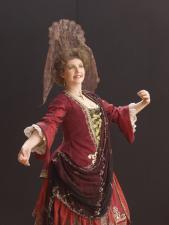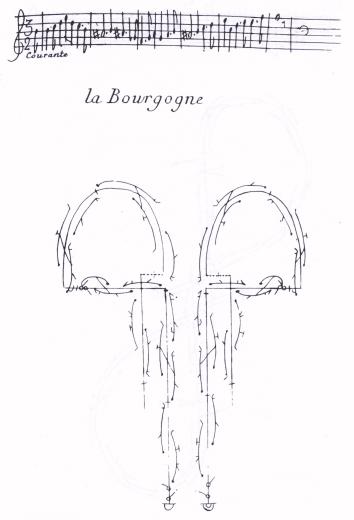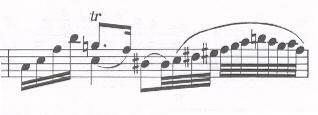
A statement made by Nathaniel Rosen about the Bach Cello Suites has been bugging me for years:
Having never seen a Baroque dance, how could I know if this statement is correct? I've read a couple of books on Baroque dance, but, like learning to play the cello, a one can't get an intuitive sense of such a kinesthetic subject from a book.
As luck would have it, I recently discovered that Anna Mansbridge, a Baroque dance specialist, had moved to my hometown, Seattle. She hails from the United Kingdom, where she studied for many years with teachers foremost in the dance profession. She holds degrees from Bedford College (UK) and Mills College in California. She has taught and performed Baroque dance in the United Kingdom and other parts of Europe, including Norway, Sweden, and Croatia. A resident of Seattle since 1998, she returns to Europe regularly to stage operas and teach early music courses. In 1995 she co-founded Footwork OffLimits, a dance company that blends early and modern dance genres. In Seattle, where she teaches Baroque dance, she is the artistic director of Seattle Early Dance and an artist-in-residence for the Washington State Arts Commission (2001-2003). I could finally pose my many questions to a Baroque dance specialist and watch her dance allemandes, courantes, bourrées, etc.

Today's Baroque dancers, like instrumentalists, struggle with the fact that there is no way of knowing for sure how people danced in the Baroque era. They can't pop in a video and watch dancers from the 1700's. They too have to rely on treatises that were written at that time. In addition to the usual sources that musicians rely upon -- C.P.E. Bach, Muffat, Rameau, etc. -- they have the good fortune of having rather detailed books that were written by Baroque dance masters, such as the one by Kellom Tomlinson, called The Art of Dancing, written in 1735. Rather florid descriptions of the various dance moves are provided in these books, in addition to diagrams of the various choreographies. See Example 1, which depicts a choreography of a courante. The steps are shown for a pair of dancers.

It was refreshing to learn from Mansbridge that the Baroque dance world is as full of controversy about how something should be danced as the cello world is about how the Bach Cello Suites should be played. After a performance in Belgium, an early dance expert in the audience once haughtily confronted her, "Why do you plié after you jump?" Dancers argue just as passionately as musicians do about what can be considered "correct" performance practice.
It seems that steadiness of pulse is one point of contention in the dance world, and this goes back to the Baroque era, if not before. Dance Master Kellom Tomlinson wrote in 1735,
This is an 'out' that dancers sometimes cite when they feel that they have to justify a spontaneous arhythmic outburst. But Kellom Tomlinson, who clearly prefers a steady pulse, goes on to say in the same paragraph:
This leads me to conclude, perhaps not surprisingly, that maintaining a steady pulse when playing the Bach Suites is more in keeping with the practice of the Baroque era, if one were to play these as if they are dances (not to mention that, practically speaking, it's extremely difficult to dance to music that doesn't have a steady pulse). The fact that we are playing a work for a solo instrument does not mean that we should suddenly throw out the notion of playing in time. Of course, I choose to cite the latter part of the aforementioned paragraph to justify my own point of view.
In a handout that Mansbridge uses in her Baroque dance classes, she writes:
This description very accurately describes how Mansbridge dances. Though I get the sense that there is a passionate human being dancing before me, especially in certain Sarabandes, her moves and demeanor are very regal, and her feelings are expressed coyly with poise and elegance. It's difficult not to be transported into an imaginary royal court as she steps around the room. With this new understanding, I can't help but wonder whether it is inappropriate to play the Bach Suites in a passionate, red-blooded manner, like so many do. Perhaps, if one is striving to play in a more Baroque style, a more controlled, refined approach is best.
In order to get a sense of the various movements in the Bach Cello Suites from a dancer's perspective, I, along with my cello, met Mansbridge at a dance studio. She danced as I played through each of the movements (except the Preludes), so that I could get a sense of their style and tempos.
What became clear is that the Bach Cello Suites really aren't meant to be danced to, though there are some movements that work better than others; the sarabandes, bourrées, and minuets usually work the best. A true Baroque dance piece has an obvious 'tune,' a clear sense of pulse (i.e. the music has a strong beat) and clear, regular phrasing, usually eight bars in length. Mansbridge said that "dance music in the Baroque era tends to be very predictable." Not many of the movements in the Bach Cello Suites meet these requirements. Bach used the dance forms as mere starting points and, through his boundless imagination, he stretched and molded them to suit his own fancy.
Truls Mørk said in his 1999 ICS interview:
You will see later in this article that this statement may be partly true, if one follows Mansbridge's advice, since it depends on which dance form is under discussion. With Mansbridge, the dance tempos were often faster, not slower as Mørk suggests, than those used by cellists, even today's baroque cellists.
The most problematic suite from a dance perspective is the c minor Suite. In this Suite, Bach unleashes his creative genius and, at times, stretches the dance forms almost to the point of them being unrecognizable. Mansbridge said that "if the Fifth Suite were to be danced to, the dance would have to be modernized in order for it to work in certain places. This Suite would be a fun challenge for a choreographer."
So let's go through each of the dances. Note that the tempi mentioned below are what feels right to Mansbridge. Tempo is a point contention in the dance world, so I'd use her suggestions as guides for the basic "feel" of the dances, not as strict doctrine.
The scholarly book, Dance and the Music of J.S. Bach, by Meredith Little and Natalie Jenne, has only limited discussion of the allemande because "by Bach's time they no longer reflected a particular dance form. In a study of allemandes of this period, [the authors] discovered neither clear choreographic roots nor distinguishable recurring rhythmic patterns; nor did [they] find any choreographies." 6
According to Mansbridge, "there aren't many allemandes in the notation. There is one from 1702 that is a duet for a man and a woman. There's another one called the 'Branle d'Allemande,' which is from 1715, but there aren't actually very many otherwise." But she does have experience with the allemandes of composers other than Bach, "Bach's allemandes feel very different from dance allemandes. When I've heard recordings of Bach's instrumental allemandes, they've sounded nothing like the allemandes that I know!"
Before I played the G Major Allemande for her, she counted out a typical Allemande tempo of around 100 beats per minute (quarter notes). After I started, she immediately said, "I can't dance that. The music is too jumpy." There was no tempo that would solve this for her. Bach had completely broken with the traditional danced allemande form.
I then played the d minor Allemande for her. Again, at a tempo of around 100 beats per minute (quarter notes), she found her stride, but, again, felt that the music was too irregular to be appropriate for dancing. Bach also completely deviates from the dance form when he inserts the cadenza-like passage in measure 9 (see Example 2), which is great as an instrumental effect, but not great for dancing.

At a tempo of 100 (eighth notes), the C Major Allemande came to life for her. The piece has a clear sense of beat, so this is the best of all the Allemandes from a dance perspective. She hastened to point out some irregular and overlapping phrasing that would have to be accounted for if the piece were choreographed (i.e. measure 2, third beat, see Example 3). Again, regular 8-bar phrases are more standard for dancing.

The E-flat Allemande has too many runs to be true dance piece. In order to make it dance-able, I had to accent each quarter note so that the music had a crystal-clear beat. The piece also lacks the clear melodic character that true Baroque dance music has. This Allemande is clearly more of an instrumental work.
I started the c minor Allemande, but it was quickly determined that the music felt too unstructured from a dance perspective. Similarly, the D Major Allemande, didn't stand a chance. "It's lovely, but it wouldn't work for baroque dance. There are lots of possibilities with modern choreography, however."
We next went through the Courantes. I was immediately taken aback by the slow tempo she requested. It turns out that Courantes were considered slow dances. In 1725, Pierre Rameau wrote that the courante is a "very solemn dance with a nobler style and grander manner than the others, is very varied in its figures, and has dignified and distinguished movements." This is corroborated in Dance and the Music of J.S. Bach, "The French Courante was variously described as serious and solemn, noble and grand, hopeful, majestic, and earnest." 7 This is a far cry from the more upbeat character with which courantes are usually played by cellists.
Her tempo for the G Major Courante was approximately 56 beats per minute (quarter notes). The piece starts out very nicely from a dance perspective at this tempo, but it quickly becomes too instrumental with the many eighth notes and sixteenth-note runs and sequences. This notion continues throughout all the suites, except for the C Major Suite. The C Major Courante is composed entirely of eighth notes, a regularity that works very well from a dance perspective, especially if the quarter-note beats are emphasized (i.e. notes inégale).
Since the Courantes sound entirely wrong to my ears at this slow tempo, I did a little more digging into the literature and discovered that Dance and the Music of J.S. Bach calls these movements "Correntes" instead of "Courantes." They define Correntes:
This definition seems to fit most of the "Courantes" in the Bach Cello Suites. The only true Courante, according to Dance and the Music of J.S. Bach is in the c minor Suite. The c minor Courante does sound pretty good at Mansbridge's tempo. Interestingly, all of the known Bach Cello Suite source manuscripts label these movements as "Courantes," while the first known published edition (Norblin, 1825) labels them all, including the one in c minor, as "Correntes."
We then went through the Sarabandes, which usually work well as dance pieces, since they have a clear sense of pulse and regular phrase lengths. She has actually used the E-flat Sarabande in dance programs. Her tempo was faster than I'm used to, approximately 72 beats per minute (quarter notes). At this tempo, it's more difficult for the cello to maintain a rock steady pulse because of the many chords in these movements, especially the D Major Sarabande. She reminded me that Sarabandes are considered the second slowest movements in dance, the slowest being Courantes. The one that wasn't good dance material was the c minor Sarabande, which Mansbridge found "too weird" from a dance perspective. I can well imagine playing the c minor Sarabande for a Baroque royal court and watching their puzzled looks as they try to figure out how to dance to it.
The second beat should not be consistently emphasized in Sarabandes. According to Mansbridge, this is apparent "in the choreographies for the sarabande, where not all the steps lend themselves to emphasizing the second beat." Instead, the emphasis should vary from measure to measure, which greatly adds to the musical interest of the piece, i.e. one-TWO-three, one-TWO-three, ONE-two-three, ONE-two-three, or however the music suggests it. This should become clear when one looks at Bach's Sarabandes in the Cello Suites. Emphasizing the second beat in each measure would sound a little odd.
Our discussion of minuets, bourrées, gavottes, and gigues yielded fewer surprises, so we went quickly through these movements. Minuets are counted in 6 in the dance world -- not in eighth notes, but in quarter notes over two measures. Her tempo was around 126 beats per minute (quarter notes). According to Mansbridge, there is some controversy about the correct tempo in minuets. "Some theorists in the 18th century describe them as gay and brisk and other ones say they should be slower and majestic." The minuets in the Cello Suites generally work very well for dance because "they are quite symmetrical in phrase length. The cellist doesn't have long drawn-out chords so the pulse is usually not lost."
Bach's bourrées work well for dance and Mansbridge has used them in her performances. Her tempo was around 96 beats per minute (quarter notes). Of the C Major Bourrée, she said, "It's got that nice chirpy tune and even phrasing." The first E-flat Bourrée "has a lovely echo. If I were to choreograph that one, I'd use a duet and have dancers echoing each other."
Interestingly, the 1825 Norblin edition calls the C Major and E-flat Major Bourrées "Loures," which none of the manuscripts do, nor does Dance and the Music of J.S. Bach. My music dictionary describes the loure as "a 17th dance ... in moderate 6/4 time and with dotted rhythms leaning heavily on the strong beats," 9 which doesn't seem to fit the bourrées in the cello suites.
The Gavottes have a full upbeat, which is typical of this dance form. Mansbridge's tempo was approximately 76 beats per minute (half-notes). The second D Major Gavotte is particularly challenging from a dance perspective because the beat is less clear and because it uses purely instrumental effects, like in measure 13 (see Example 4), which would confuse the unsuspecting dancer.

Her tempo for the Gigues was around 96 beats per minute (dotted quarter notes), which made the D Major Gigue incredibly challenging to play (as if it isn't challenging at a slower tempo!). The gigues have a strong sense of a pulse, but they often lapse into purely instrumental works (i.e. measure 21 of the C Major Gigue, see Example 5), so they are not ideal for dancing. Modern choreographic elements would be needed if the gigues were to be danced to.

Dance and the Music of J.S. Bach further reinforces the notion that the gigues are not meant to be danced to. They divide gigues into three subcategories -- the French Gigue, Giga I, and Giga II -- the latter two clearly being instrumental instead of dance music. They refer to the c minor Gigue as a "French Gigue," of which they write:

The E-flat Major Gigue falls in the Giga I category, which "are soloistic excursions for virtuoso performers � little information is available on the performance style of Giga I�." 11 The G Major, d minor, C Major, and D Major are referred to as "Giga II's," which are "Bach's most complex, exploratory, and challenging gigues� They are complex because there is another metric level below the tripleness." 12
After going through all the dance movements with Anna Mansbridge, I determined that Nathaniel Rosen was basically right. These suites really aren't meant to be danced to, because Bach used the dance forms as mere starting points in his compositional process. As Mansbridge said,
The question we must ask ourselves is whether this new understanding of Baroque dance is going to change how we play these Suites? Do we play the Courantes like true Courantes (i.e. slower) or do we play them faster, like Correntes? Do we play Sarabandes much faster, forcing those beautiful rolling chords to be more 'in time'? Or do we continue to play them in a more ponderous tempo? Do we continue to infuse the Suites with gut-wrenching emotion, or do we remain somewhat distant, allowing 'Reason' to rule over our 'Passions.' I'll leave these questions to you.
1. Statement made in Nathaniel Rosen's 1996 Internet Cello Society Featured Artist Interview with Tim Janof.
2. Louis Pecour, Recueil de Danses and La Nouvelle Galliarde, (Paris, 1700), Gregg International Publishers Limited, London, 1970, p. 47.
3. 'The Art of Dancing' explained by reading and figures; whereby the manner of performing the steps is made easy by a new and familiar method: being the original work, first designed in the year 1724, and now published by Kellom Tomlinson, dancing master....London: the author, 1735.
4. Ibid.
5. Statement made in Truls Mørk's 1999 Internet Cello Society Featured Artist Interview with Tim Janof.
6. Meredith Little and Natalie Jenne, Dance and the Music of J.S. Bach, Indiana University Press, Bloomington, 1991, p. 34.
7. Ibid. p. 115.
8. Ibid. p. 128.
9. Don Michael Randel, Harvard Concise Dictionary of Music, Belknap Press of Harvard University Press, Cambridge, 1978, p. 281.
10. Meredith Little and Natalie Jenne, Dance and the Music of J.S. Bach, Indiana University Press, Bloomington, 1991, p. 145.
11. Ibid. p. 159-160.
12. Ibid. p. 164.
11/02/02

| Direct correspondence to the appropriate ICS
Staff Editor: Tim Janof Director: John Michel Copyright © 1995- Internet Cello Society |
|---|